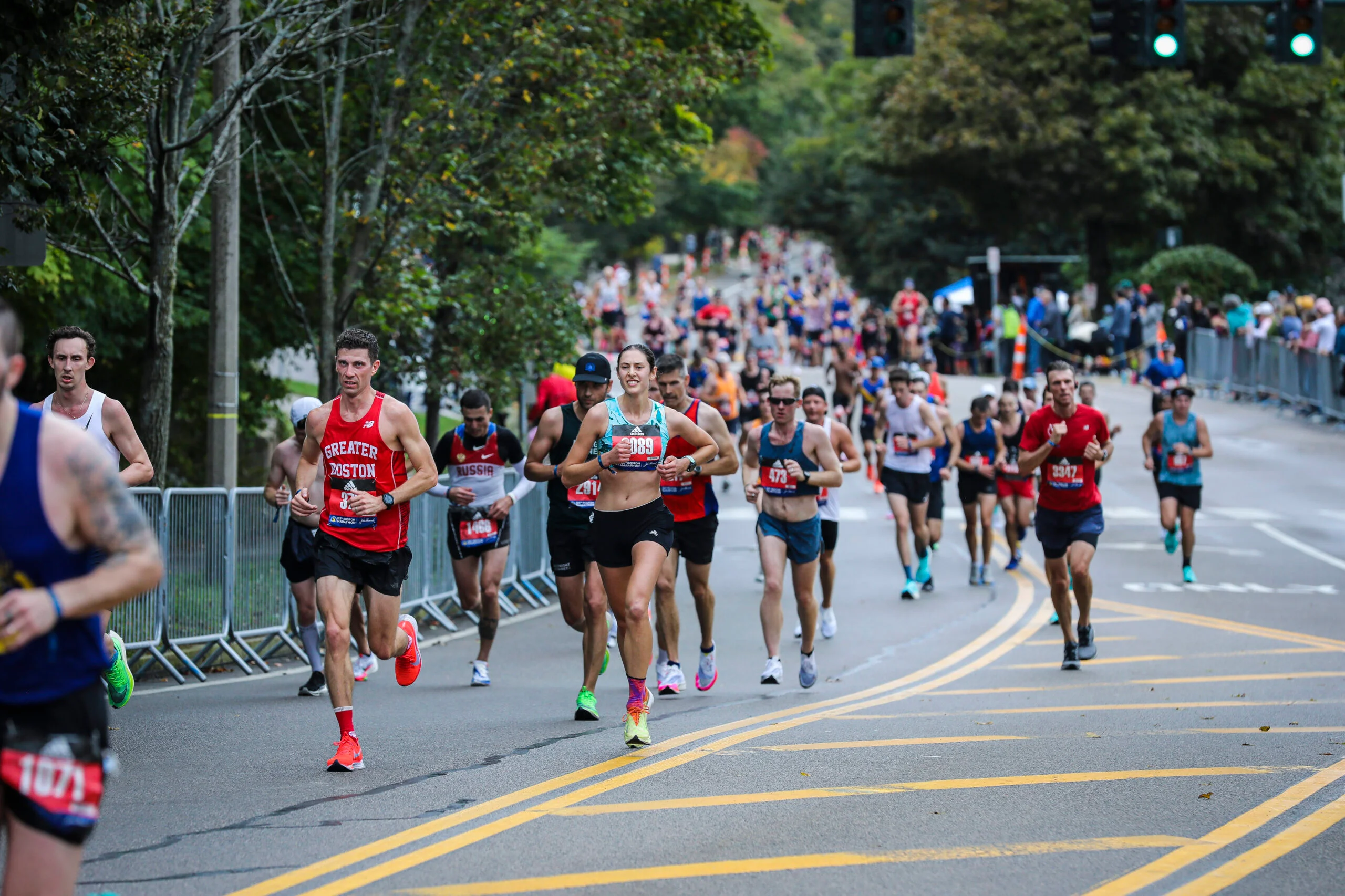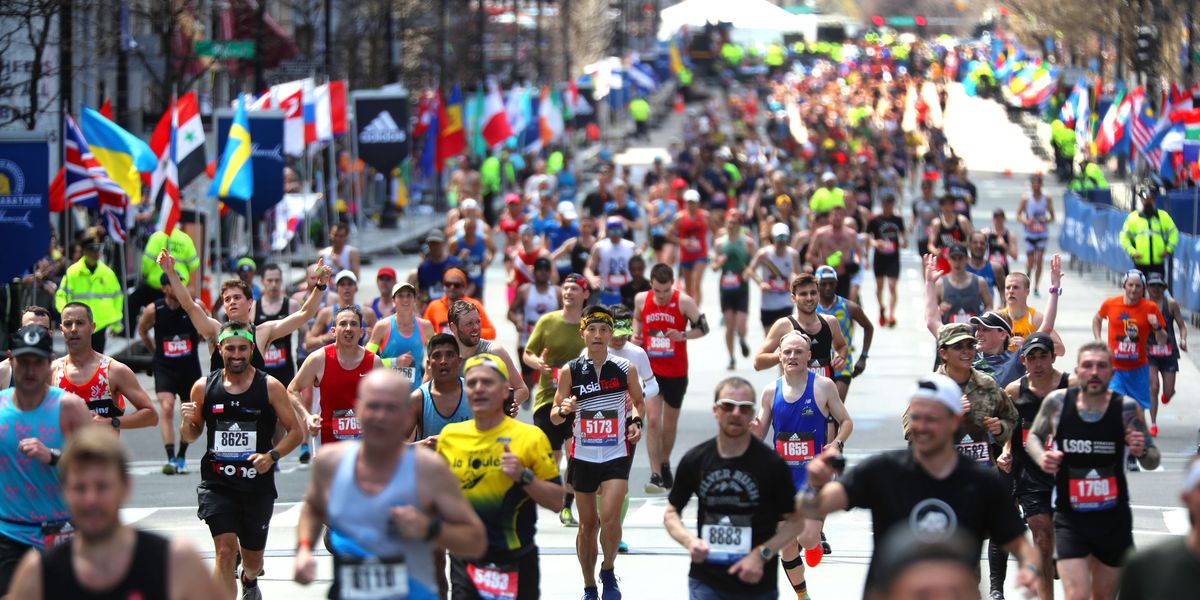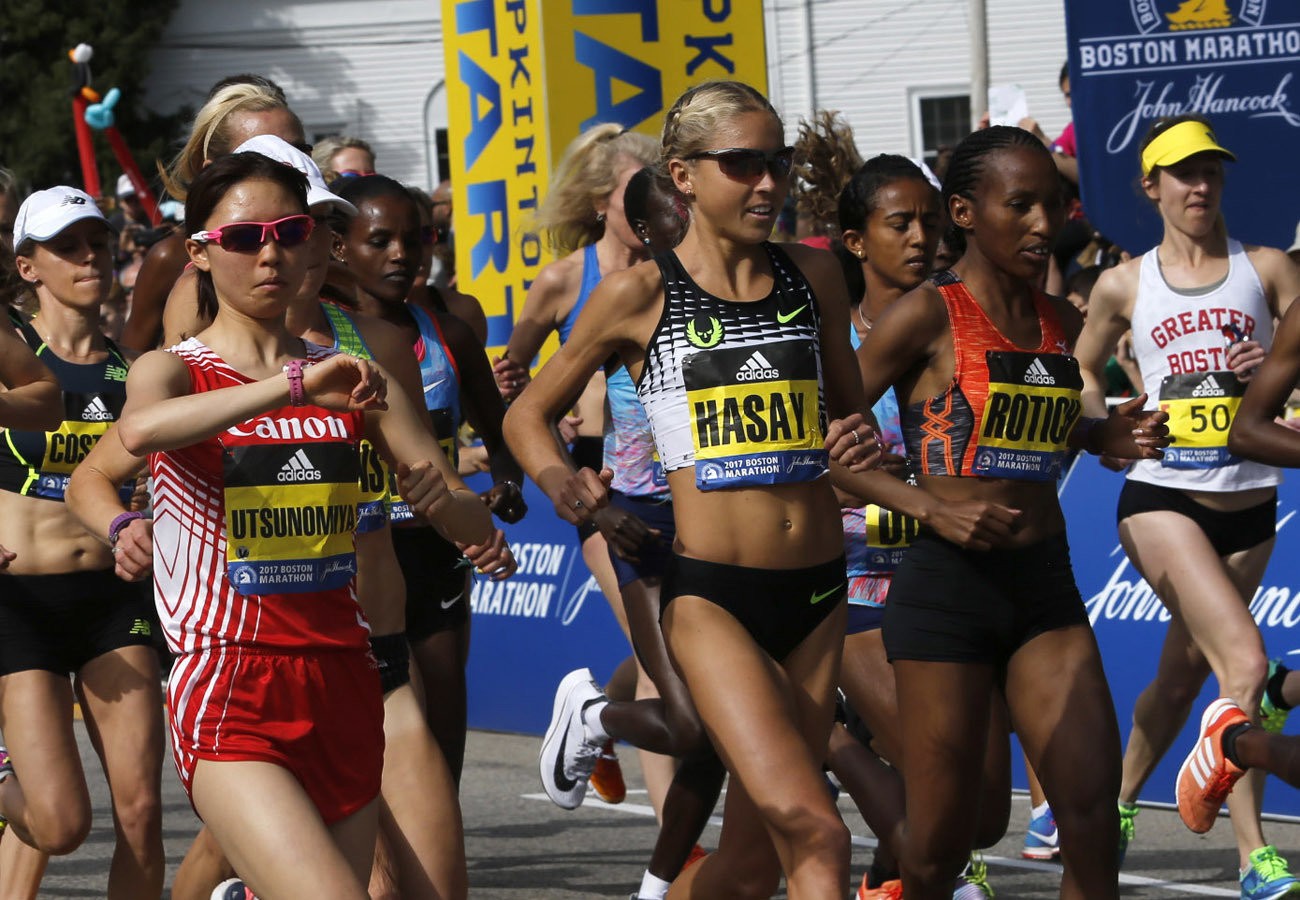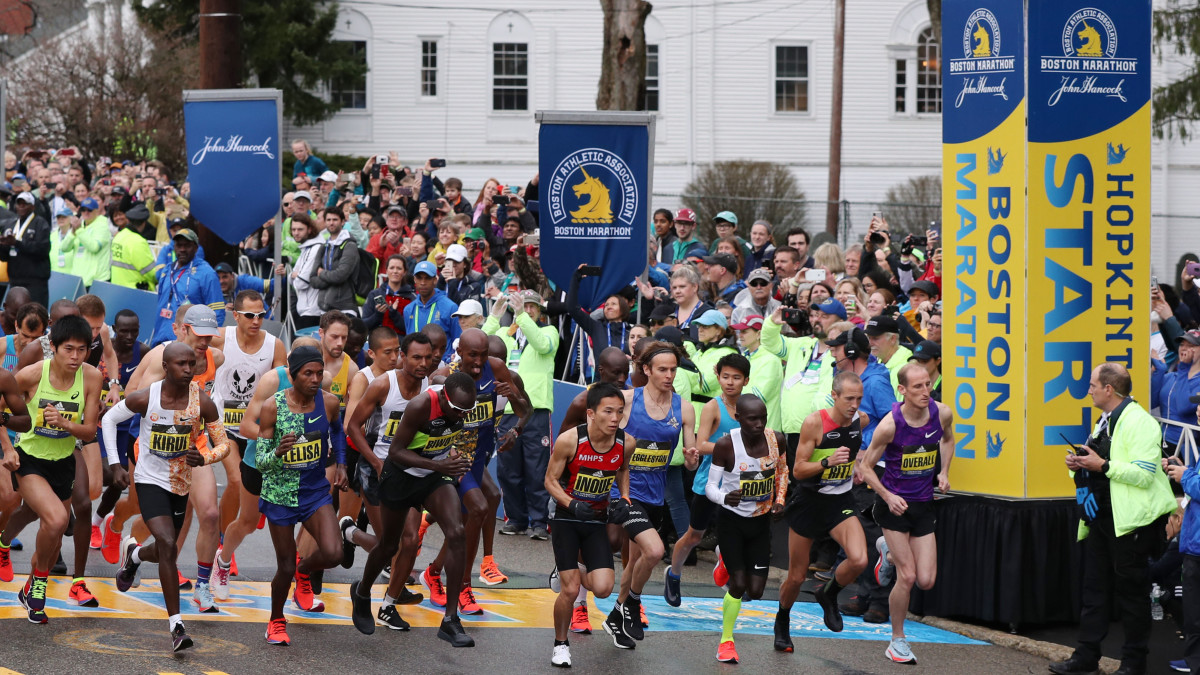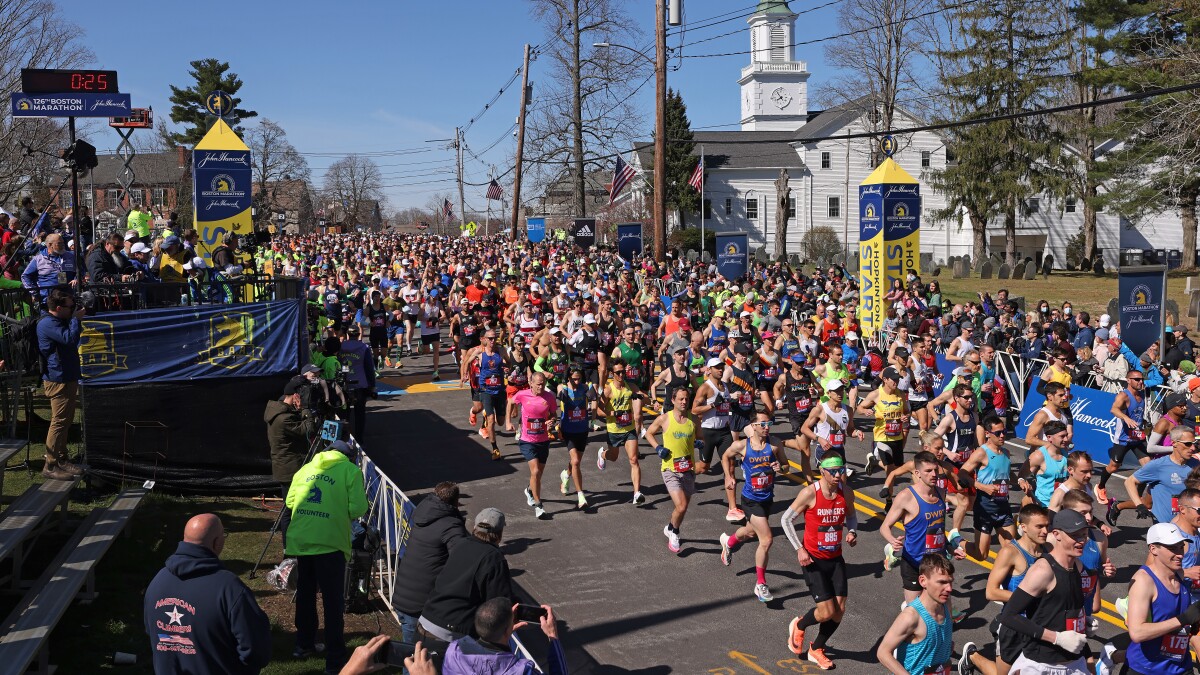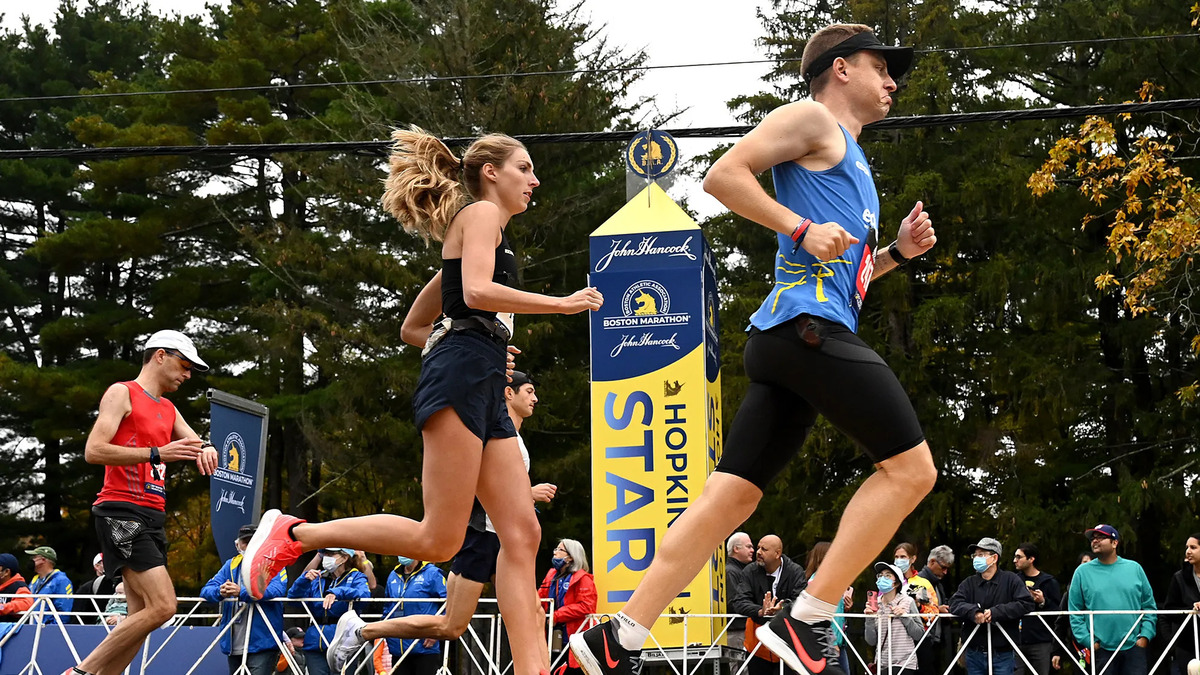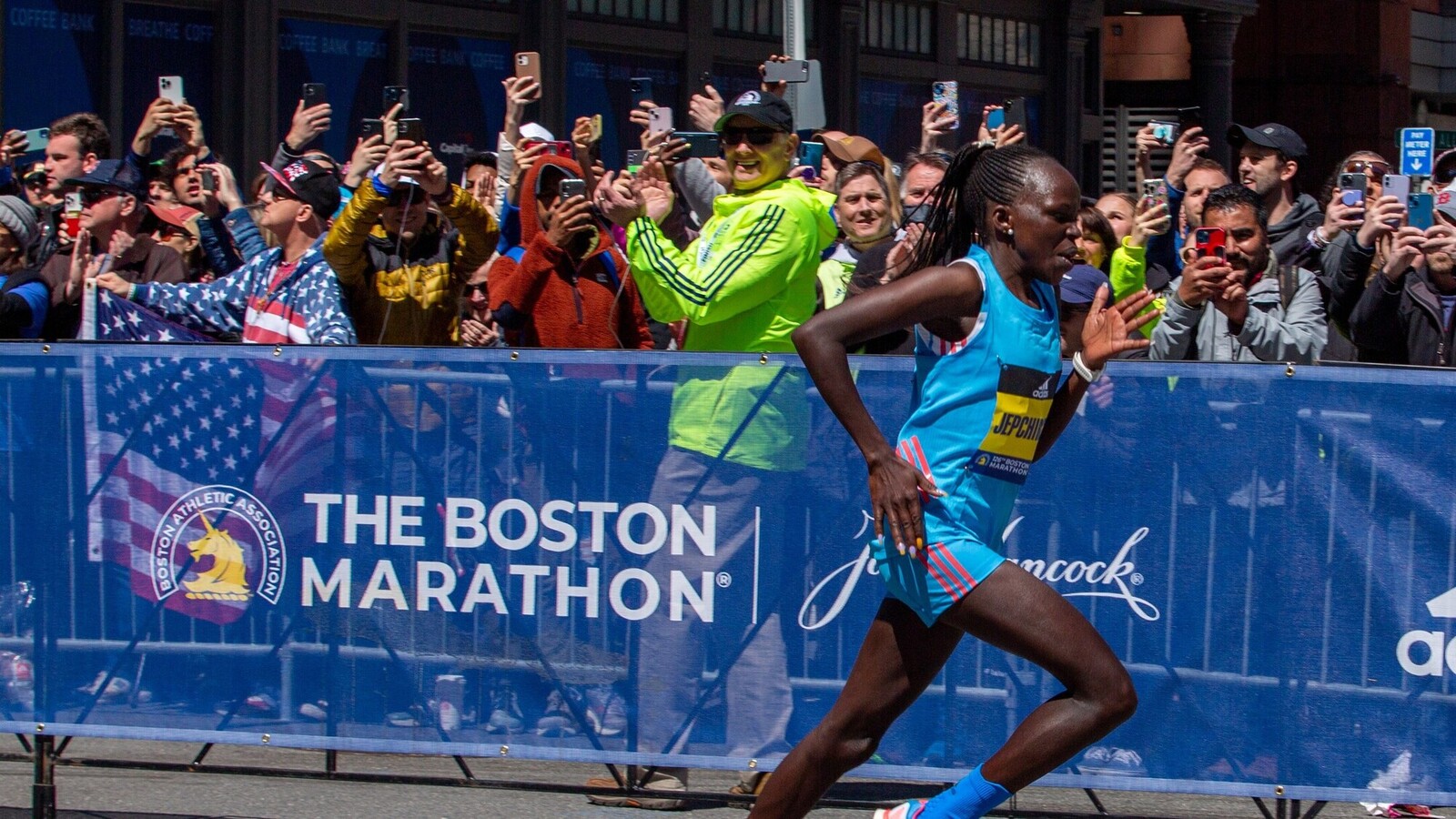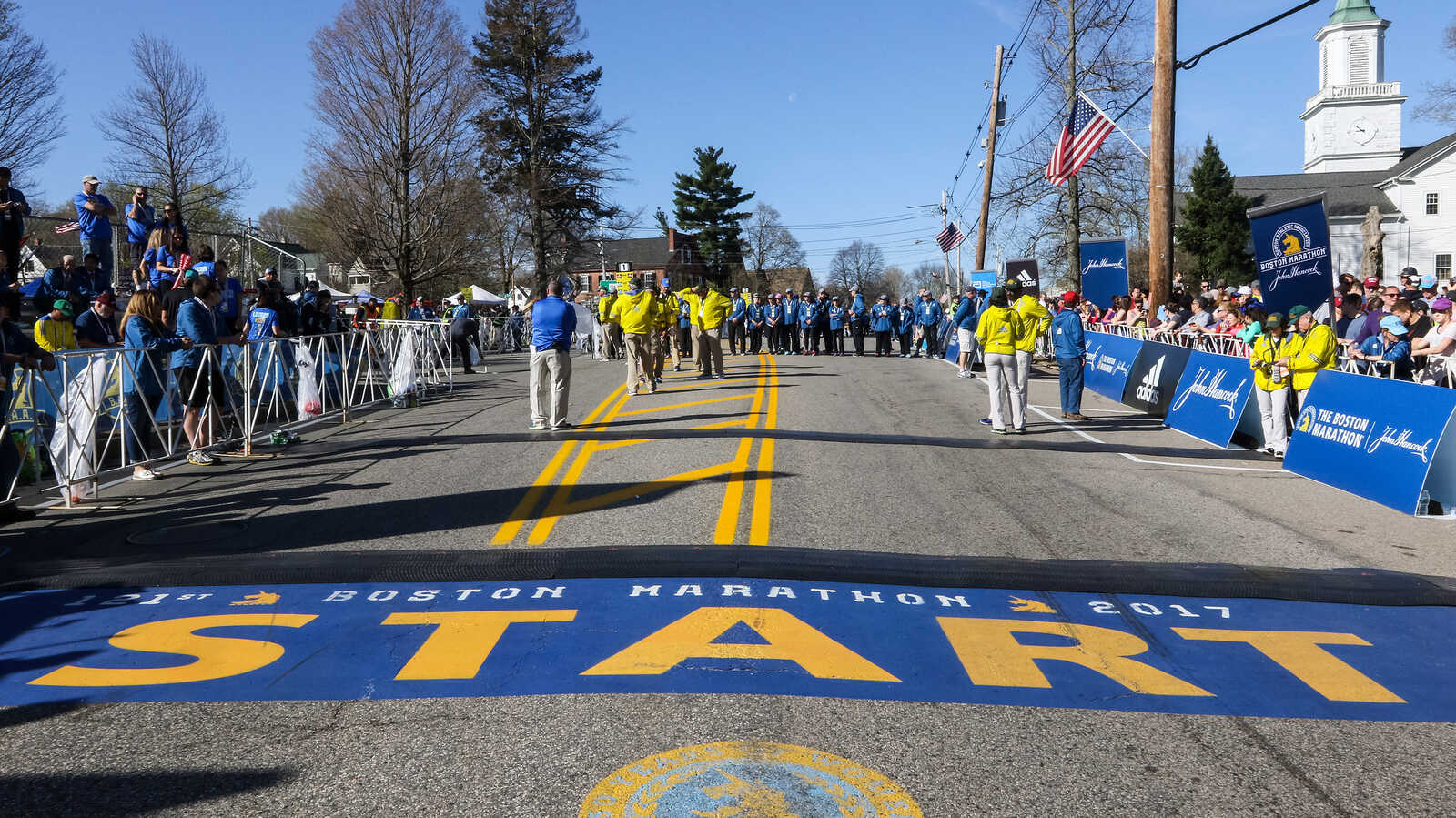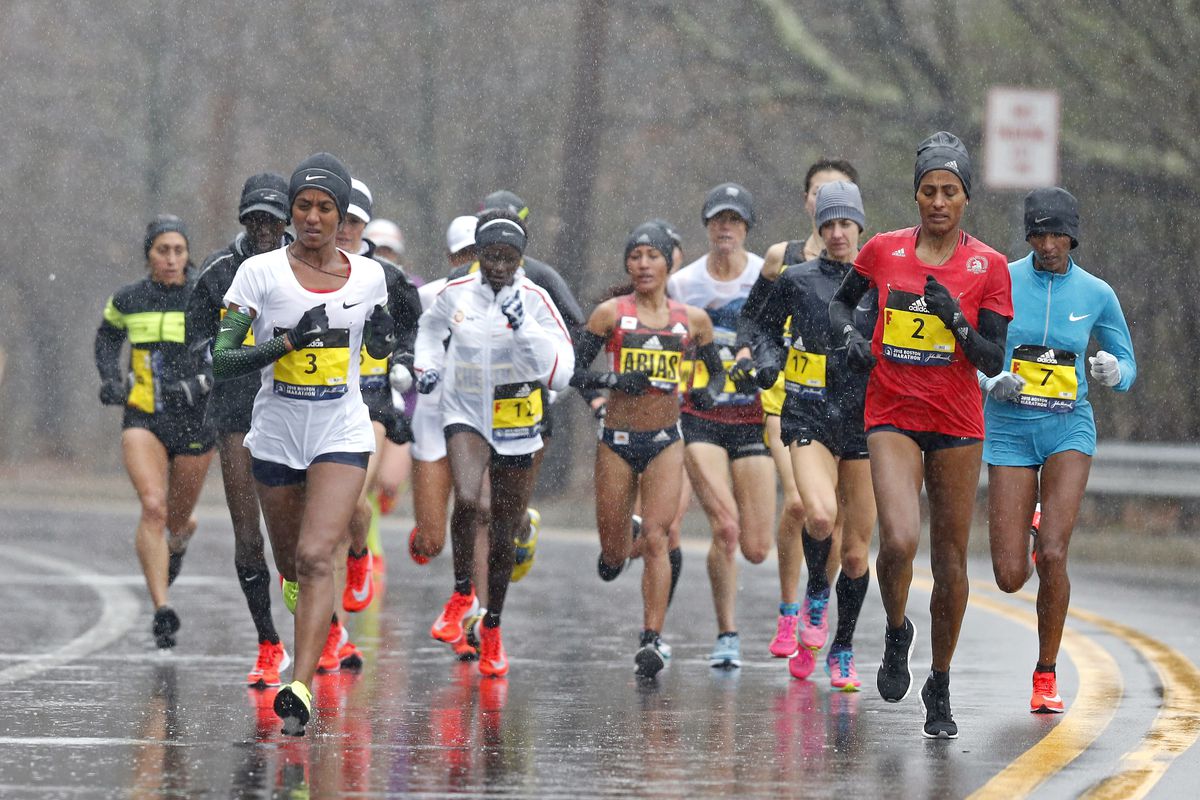

Featured
How To Run In The Boston Marathon
Modified: January 22, 2024
Discover the key tips and tricks you need to know to run in the Boston Marathon. Don't miss out on this featured event for avid runners!
Introduction
Welcome to the world of marathon running, where the thrill of crossing the finish line is unmatched. And if there’s one marathon that stands out amongst the rest, it’s the historic and prestigious Boston Marathon. With its rich history and challenging course, running the Boston Marathon is a dream for many ambitious runners.
Founded in 1897, the Boston Marathon is the oldest annual marathon in the world and attracts thousands of participants from all corners of the globe. Known for its tough qualifying standards, it is an achievement in itself just to secure a spot on the starting line. Whether you’re a seasoned marathon runner or a first-timer, the combination of training, preparation, and sheer determination is key to successfully completing this iconic race.
In this article, we will guide you through the journey of training for and running the Boston Marathon. From the initial preparation to crossing the finish line, we’ll cover all the essential aspects that will help you reach your goals and make your Boston Marathon experience a memorable one.
Before we dive into the nitty-gritty details, it’s important to note that running a marathon is a significant physical and mental challenge. It requires discipline, commitment, and a well-rounded approach to training, nutrition, and recovery. So, lace up your running shoes, grab a water bottle, and let’s embark on this thrilling marathon journey together!
Training for the Boston Marathon
Training for the Boston Marathon is a rigorous process that requires careful planning and dedication. It’s crucial to build a strong foundation of endurance and gradually increase mileage to prepare your body for the demands of the race. Here are some key tips to keep in mind:
1. Develop a training plan: Start by creating a comprehensive training plan that includes a mix of long runs, speed workouts, and recovery days. Gradually increase your weekly mileage, ensuring you give your body enough time to adapt and recover between runs.
2. Incorporate cross-training: While running forms the foundation of your training, don’t underestimate the benefits of cross-training. Activities like cycling, swimming, or strength training can help improve your overall fitness, prevent injuries, and provide variety to your training regimen.
3. Hill training: The Boston Marathon is known for its challenging course with several significant hills. Incorporate hill workouts into your training to build strength and endurance, simulating the race conditions as closely as possible.
4. Practice race pace runs: To familiarize yourself with marathon pace, incorporate race pace runs into your training. This will help you gauge your speed, establish your target pace, and mentally prepare for the race day.
5. Listen to your body: Pay close attention to any signs of fatigue or injuries during training. Adjust your mileage or take rest days when necessary to prevent overtraining. Ignoring warning signs can lead to setbacks and hinder your performance on race day.
6. Get proper rest and recovery: Training for a marathon is physically demanding, so prioritize rest and recovery. Make sure to get enough sleep, eat nutritious meals, and incorporate stretching and foam rolling into your routine to aid in muscle recovery and prevent injuries.
Remember, training for a marathon is a journey, not a sprint. Be patient, stay committed, and trust the process. With consistent training and perseverance, you’ll find yourself well-prepared to conquer the Boston Marathon.
Choosing the Right Gear
When it comes to marathon running, choosing the right gear is essential for your comfort, performance, and overall experience. Here are some factors to consider when selecting your gear for the Boston Marathon:
1. Running Shoes: Invest in a good pair of running shoes that provide proper support, cushioning, and stability. Consider visiting a specialty running store to get fitted by a professional who can analyze your gait and recommend the most suitable shoes for your foot type and running style.
2. Clothing: Dress appropriately for the weather conditions on race day. Opt for moisture-wicking, breathable fabrics that will keep you comfortable and help regulate your body temperature. Avoid cotton, as it tends to retain moisture and can lead to chafing and discomfort.
3. Technical Fabrics: Look for technical fabrics, such as polyester or nylon blends, that offer moisture-wicking properties to keep sweat away from your skin. These materials dry quickly, preventing irritation and chafing during long runs.
4. Compression Gear: Consider wearing compression socks, sleeves, or tights, which have been shown to improve circulation, reduce muscle fatigue, and enhance recovery. They can also provide additional support for your calves and minimize the risk of injury.
5. GPS Running Watch: A GPS running watch can be a valuable tool for tracking your pace, distance, and workout data. It can help you stay on track during training runs and provide valuable feedback on your progress and performance.
6. Hydration Gear: It’s crucial to stay hydrated during the marathon. Choose a hydration system that works for you, whether it’s a handheld water bottle, a hydration belt, or a hydration vest. Practice using it during your training runs to ensure comfort and convenience.
7. Accessories: Don’t forget about the little things that can make a big difference. Consider wearing a hat or visor to protect yourself from the sun, sunglasses to shield your eyes, and sunscreen to prevent sunburn. Body glide or anti-chafing cream can help prevent friction and irritation during the race.
Remember, it’s important to test your gear during your training runs to ensure comfort and functionality. Avoid trying anything new on race day to minimize the risk of discomfort or unexpected issues. Choose your gear wisely, and you’ll be well-prepared to tackle the Boston Marathon with confidence.
Nutrition and Hydration Tips
Proper nutrition and hydration play a crucial role in marathon training and race day performance. Here are some key tips to fuel your body for the demands of the Boston Marathon:
1. Balanced Diet: Focus on consuming a well-rounded diet that includes a mix of carbohydrates, protein, and healthy fats. Carbohydrates are vital for energy, so incorporate whole grains, fruits, and vegetables into your meals. Protein helps with muscle repair and recovery, so include lean sources like chicken, fish, and tofu. Don’t forget to include healthy fats from sources like avocados, nuts, and olive oil.
2. Pre-race Fueling: Eat a balanced meal or snack containing carbohydrates, protein, and a small amount of healthy fats a few hours before your training runs and on race day. Experiment during your training to find the foods that work best for you and provide sustained energy without causing gastrointestinal discomfort.
3. Hydration: Stay well-hydrated throughout your training and on race day. Drink water consistently throughout the day, aiming for at least 64 ounces (approx. 2 liters) daily. During long runs, use electrolyte-rich sports drinks or gels to replenish fluids and essential minerals lost through sweat.
4. Fueling During the Race: Develop a race day fueling strategy based on your training runs. Experiment with different energy gels, chews, or snacks to find what works best for you. Aim to consume around 30-60 grams of carbohydrates per hour to maintain energy levels and prevent depletion.
5. Post-run Recovery: Proper recovery is key to optimizing your training and preparing for future runs. Refuel your body with a combination of carbohydrates and protein within 30-60 minutes of completing your run. This can be achieved through a protein shake, a meal consisting of lean protein and whole grains, or a balanced snack.
6. Nutritional Timing: Pay attention to what you eat and when you eat it. Incorporate carbohydrates into your pre-workout or pre-race meals to provide a readily available source of fuel. During longer runs or races, consume carbohydrates and electrolytes at regular intervals to sustain energy levels.
Remember, nutrition is highly individual, and what works for one person may not work for another. Take the time to understand your body’s needs, experiment with different foods and hydration strategies, and seek guidance from a registered dietitian if needed. With proper nutrition and hydration, you’ll be well-fueled to tackle the Boston Marathon with ease.
Injury Prevention and Recovery
Training for a marathon can put a significant strain on your body, increasing the risk of injuries. Taking preventive measures and implementing effective recovery strategies are vital for staying healthy and maintaining your training schedule. Here are some key tips for injury prevention and recovery during your Boston Marathon training:
1. Gradual Progression: Avoid sudden increases in mileage or intensity. Gradually increase your mileage by no more than 10% per week to give your body time to adapt and reduce the risk of overuse injuries.
2. Strength Training and Cross-Training: Incorporate strength training exercises into your routine to build muscular strength and stability. Focus on strengthening your core, hips, and lower body to support proper running mechanics. Cross-training, such as swimming or cycling, can provide a break from running while still maintaining cardiovascular fitness.
3. Listen to Your Body: Pay attention to any signs of pain or discomfort during your training. Don’t ignore them or try to push through. Rest, ice, and seek professional advice if necessary to prevent minor issues from turning into serious injuries.
4. Proper Warm-Up and Cool-Down: Always engage in a dynamic warm-up before your runs to increase blood flow and loosen up your muscles. Use a foam roller or do gentle stretching exercises after your runs to aid in muscle recovery and reduce muscle soreness.
5. Cross-Training for Recovery: When recovering from intense workouts or long runs, incorporating low-impact activities like swimming, yoga, or Pilates can help reduce muscle soreness, promote flexibility, and enhance recovery.
6. Rest and Sleep: Allow for sufficient rest and recovery time between training sessions. Your body needs time to repair and rebuild tissues, so prioritize sleep and aim for 7-9 hours per night to optimize recovery.
7. Seek Professional Help: If you experience persistent pain or suspect you have an injury, consult with a sports medicine professional or physical therapist. They can evaluate your condition, provide appropriate treatment, and offer guidance on modifying your training to support recovery.
Remember, injury prevention and recovery go hand in hand. By taking proactive steps to prevent injuries and implementing effective recovery strategies, you’ll be able to maintain your training consistency and perform at your best on race day.
Mental Preparation for the Race
While physical preparation is crucial for running the Boston Marathon, the mental aspect of marathon running is equally important. A strong mental game can make a significant difference in your performance and overall race experience. Here are some key tips for mental preparation:
1. Set Realistic Goals: Before the race, set realistic goals based on your training, abilities, and current fitness level. Establish both performance goals, such as finishing within a specific time frame, and process goals, such as maintaining a consistent pace or staying mentally focused throughout the race.
2. Visualize Success: Mental imagery is a powerful tool in preparing for the race. Spend time visualizing yourself running strong, crossing the finish line, and achieving your goals. Visualize different scenarios, including challenging moments, and envision yourself overcoming them with determination and resilience.
3. Positive Self-Talk: Pay attention to your inner dialogue and replace negative thoughts with positive affirmations. Remind yourself of your training, strength, and resilience. Use phrases like “I am strong,” “I can do this,” and “I’ve prepared for this moment” to boost your confidence and motivation.
4. Develop Mantras: Create short and powerful mantras that resonate with you and reflect your goals and mindset. Repeat these mantras during the race to stay focused and motivated. Examples include “I am unstoppable,” “I embrace the challenge,” or “One step at a time.”
5. Embrace the Discomfort: Accept that running a marathon is a physically and mentally demanding endeavor. Embrace the discomfort and acknowledge that it’s a natural part of the race. Instead of shying away from it, learn to embrace the challenge and use it as an opportunity to push past your limits.
6. Break the Distance: Instead of focusing on the entire 26.2 miles, break the race into smaller, more manageable segments. Focus on reaching the next mile marker or getting through the next few miles. This will help prevent feeling overwhelmed and enable you to stay mentally engaged throughout the race.
7. Establish a Race Day Routine: Develop a race day routine that includes pre-race rituals and strategies to help calm your mind and maintain focus. This could include listening to calming music, meditating, or engaging in light stretching exercises. Find what works for you and incorporate it into your routine to create a sense of familiarity and calm.
Remember, your mental state can influence your physical performance. By preparing your mind for the challenges ahead, you’ll be better equipped to navigate the race day with confidence, resilience, and a positive attitude.
Navigating the Course
The Boston Marathon course presents a unique set of challenges, from its hilly terrain to its iconic landmarks. Familiarizing yourself with the course and implementing smart strategies can help you navigate the race successfully. Here are some tips to help you tackle the Boston Marathon course:
1. Study the Course: Before race day, thoroughly review the course map and elevation profile. Identify key landmarks, water stations, and challenging sections. Knowing what to expect will mentally prepare you for the course and allow you to plan your pacing accordingly.
2. Train on Similar Terrain: If possible, incorporate training runs on hills that resemble the course’s elevation. Practice running uphill and downhill to build strength and confidence in tackling the challenging segments of the race.
3. Pace Yourself: The early downhill sections of the Boston Marathon can tempt you to go out too fast. Avoid this common mistake and aim for a conservative pace in the early miles to conserve energy for the later stages of the race.
4. Approach the Hills Strategically: The Newton hills, including the infamous Heartbreak Hill, are among the most challenging sections of the course. Conserve your energy on the early hills and maintain a steady effort. Focus on maintaining your pace and using efficient running form to power up the inclines.
5. Stay Mentally Engaged: Use the course landmarks to keep yourself mentally engaged and motivated. Look forward to cheering spectators, iconic landmarks like Wellesley College or Fenway Park, and the inspiring energy of the crowd.
6. Hydration and Fueling: Pay attention to the location of water stations along the course and develop a race day hydration and fueling plan. Practice grabbing water cups efficiently during your long training runs to minimize time loss and stay properly hydrated.
7. Mind your Surroundings: The Boston Marathon is a popular race with a large number of participants. Be mindful of your surroundings, especially when navigating through crowded areas or making turns. Maintain proper race etiquette and ensure the safety of yourself and fellow runners.
Remember, running the Boston Marathon is not just about conquering the course; it’s also about enjoying the experience and taking in the unique atmosphere. Stay focused, stay present, and embrace the challenges and triumphs of the course as you make your way towards the finish line.
Race Day Strategies
Race day is finally here, and it’s time to put all your preparation and training into action. Implementing smart strategies can help you make the most of your Boston Marathon experience. Here are some race day strategies to help you perform your best:
1. Stick to Your Plan: Trust the training you have put in and stick to your race day plan. Set a realistic pace based on your training and avoid getting caught up in the excitement and going out too fast. Patience and discipline will pay off in the later stages of the race.
2. Start Line Logistics: Arrive at the start line with plenty of time to spare. Use the restroom, check your gear, and find your designated wave and corral. Take some time to stretch, do a light warm-up jog, and mentally prepare yourself for the race ahead.
3. Fueling and Hydration: Stick to your race day fueling and hydration plan that you practiced during training. Consume gels or other energy sources at regular intervals, and hydrate at water stations. Be mindful of how your body is feeling and adjust your fueling strategy accordingly.
4. Break the Race into Segments: Mentally break the race into segments to keep yourself motivated and focused. Focus on reaching each mile marker or landmark and ticking off the segments as you progress. This will help you stay mentally engaged and prevent the race from feeling overwhelming.
5. Utilize the Crowd Support: The Boston Marathon is known for its incredible crowd support. Draw energy from the cheering spectators along the course. High-five kids, acknowledge signs, and thank supporters for their encouragement. Their positive energy can give you a boost when you need it most.
6. Stay Positive and Adjust as Needed: Embrace the highs and lows of the race and maintain a positive mindset. If you encounter challenging moments, use positive self-talk and focus on maintaining forward progress. Adjust your pace or strategy if necessary, but always keep your end goal in mind.
7. Enjoy the Experience: Remember to enjoy the journey! Take in the atmosphere, appreciate the iconic landmarks, and savor the experience of running the historic Boston Marathon. Smile, soak in the cheers, and celebrate the incredible accomplishment you are about to achieve.
Throughout the race, trust in your training, believe in your abilities, and stay mentally strong. The Boston Marathon is an incredible opportunity to showcase your hard work and dedication. Embrace the challenges, push through the barriers, and celebrate every step that brings you closer to the finish line.
Celebrating Your Boston Marathon Finish
Congratulations! Crossing the finish line of the Boston Marathon is an incredible achievement and a moment worth celebrating. After months of training and pushing your limits, it’s important to take the time to recognize your accomplishment and reflect on your journey. Here are some ways to celebrate your Boston Marathon finish:
1. Soak in the Moment: As you cross the finish line, take a moment to soak it all in. Raise your arms, give a big smile, and relish in the sense of accomplishment. You’ve just completed one of the most prestigious marathons in the world!
2. Collect Your Medal: After crossing the finish line, find the medal distribution area to receive your Boston Marathon finisher’s medal. This physical representation of your hard work and dedication is a cherished memento you’ll proudly display.
3. Meet Your Loved Ones: Coordinate a meeting spot with your family and friends before the race so they can congratulate you at the finish line. The support and encouragement of your loved ones throughout your marathon journey deserve celebration as well.
4. Reflect and Embrace the Emotions: Take some time to reflect on your journey, all the training miles, the ups and downs, and the challenges overcome. Allow yourself to experience the range of emotions that come with completing such an extraordinary feat.
5. Reward Yourself: Treat yourself to a post-race indulgence, whether it’s a massage, a delicious meal at a local restaurant, or a relaxing day at the spa. You’ve earned it after the months of hard work and dedication.
6. Document Your Experience: Share your story and race day experience with others. Write a blog post, post on social media, or create a scrapbook to capture the memories and inspire others.
7. Take Time to Recover: Post-marathon recovery is crucial for your physical and mental well-being. Rest and allow your body time to heal from the rigors of the race. Take gentle walks, do light stretching, and gradually ease back into running when your body feels ready.
8. Set New Goals: Use the momentum from completing the Boston Marathon to set new goals for your running journey. Whether it’s tackling another marathon, improving your personal best, or exploring new race experiences, let the energy of your achievement propel you forward.
Remember, crossing the finish line of the Boston Marathon is an incredible accomplishment that should be celebrated. Take the time to appreciate your hard work, celebrate your success, and cherish the memories of this extraordinary experience. You’ve joined an elite group of dedicated runners, and your Boston Marathon finish will forever be a proud moment in your running journey.
Conclusion
Congratulations on embarking on the journey of running the Boston Marathon! This iconic race is not only a test of physical endurance but also a testament to your determination and dedication. Throughout your training and preparation, you have learned valuable lessons about training, gear selection, nutrition, and mental fortitude.
As you cross the finish line of this historic race, take a moment to reflect on your accomplishment and celebrate your hard work. The Boston Marathon is more than just a race; it represents a milestone in your running journey and a symbol of resilience.
Remember, the key to achieving success in the Boston Marathon lies in your preparation. Train diligently, follow a well-structured training plan, and listen to your body. Focus on building endurance, strength, and mental resilience. Take the time to choose the right gear and practice fueling and hydration strategies during your long runs.
Maintaining a positive mindset is equally important. Visualize success, embrace the challenges, and stay mentally engaged throughout the race. Use positive self-talk, break the race into manageable segments, and draw energy from the crowd support and iconic landmarks along the course.
As you celebrate your Boston Marathon finish, remember to take care of yourself. Allow for proper rest and recovery, both physically and mentally. Reflect on your journey, appreciate the progress you’ve made, and set new goals to continue pushing yourself to new heights.
The Boston Marathon is more than just a race; it’s an experience that will stay with you for a lifetime. Cherish the memories, share your story, and inspire others with your achievements. Most importantly, continue to embrace the joy of running and the sense of accomplishment that comes with crossing each finish line.
Thank you for joining us on this marathon journey. We hope this comprehensive guide has provided you with valuable insights and tips to make your Boston Marathon experience a memorable and successful one.
